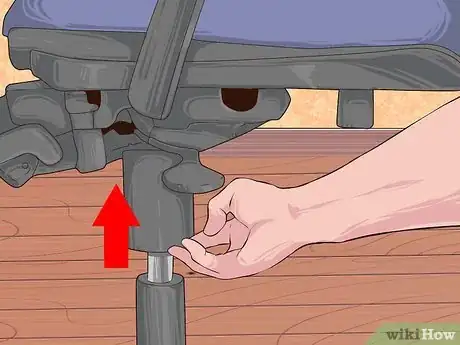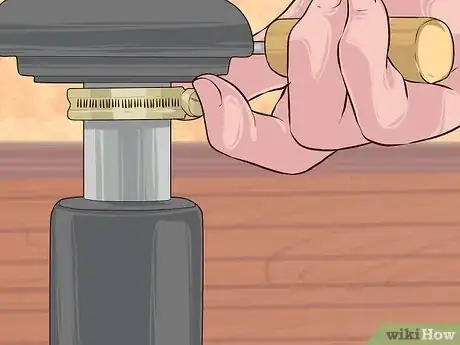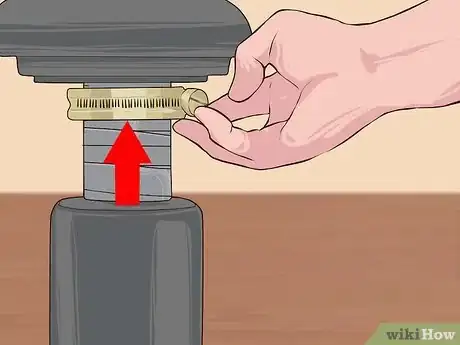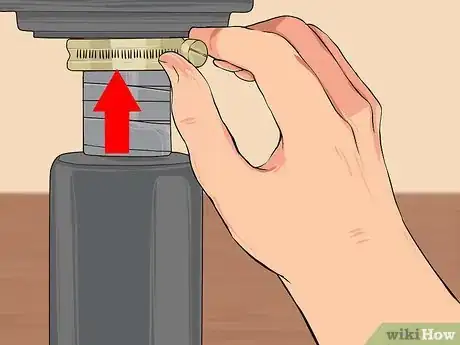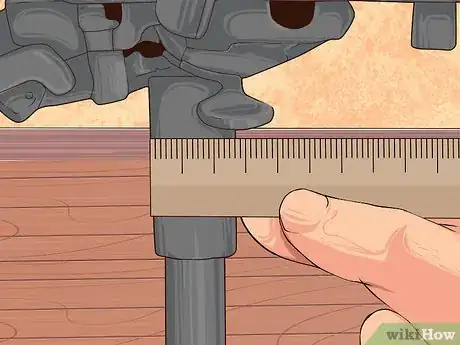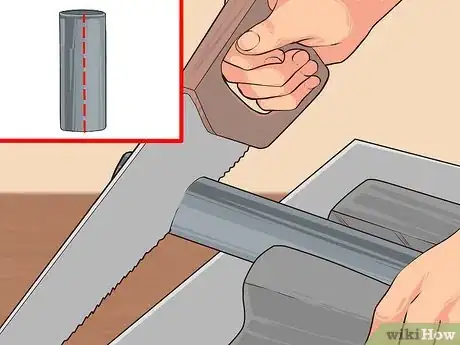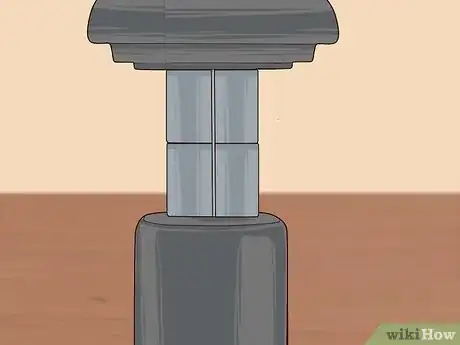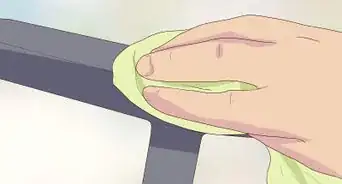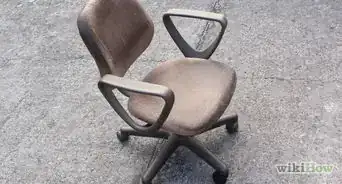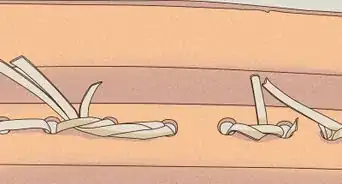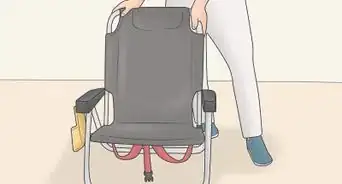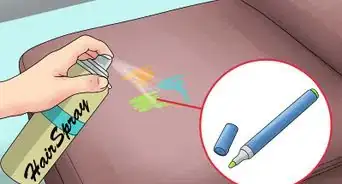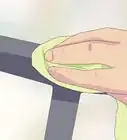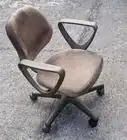This article was co-authored by wikiHow Staff. Our trained team of editors and researchers validate articles for accuracy and comprehensiveness. wikiHow's Content Management Team carefully monitors the work from our editorial staff to ensure that each article is backed by trusted research and meets our high quality standards.
wikiHow marks an article as reader-approved once it receives enough positive feedback. This article received 29 testimonials and 83% of readers who voted found it helpful, earning it our reader-approved status.
This article has been viewed 828,193 times.
Learn more...
Office chairs use a pneumatic cylinder that controls the height of the chair through pressurized air. The cylinder on most chairs fails within a few years, typically because the seals are too damaged to maintain pressure. You can buy a replacement cylinder to restore full function to your chair, but this is nearly as expensive as buying a replacement. Try these simple DIY methods instead to fix your chair at one convenient height.
Steps
Using a Hose Clamp
-
1Slide the plastic skirt off the cylinder. Most office chairs have a plastic tube over the extendable cylinder. Slide this all the way down or up, until you can see the metal cylinder underneath.[1]
-
2Set the chair to the preferred height. You will not be able to adjust the height after this repair, so make sure you have it right. The seat of the chair should be level with your knees when you are standing.
- If the chair won't stay up even when no one is on it, lay it on its side.
- If the plastic skirt covers the cylinder at this height, you will need to remove the skirt first. To do this, turn the chair upside down, push the retaining clip at the base with a screwdriver, and pull off the wheels, then the skirt. Slide the wheels back on.
Advertisement -
3Wrap a hose clamp around the cylinder. Get a ¾" (2 cm) hose clamp (Jubilee Clip) from a hardware store. Loosen the screw on the hose clamp (Jubilee Clip) and pull out the belt end. Wrap the clamp around the metal cylinder, but do not tighten it yet.
-
4Improve the grip of the clamp (recommended). The clamp will need to be very tight to hold the chair up. Give the clamp a better surface to grip by wrapping a strip of rubber or a couple layers of duct tape around the cylinder.[2] Do this at the highest visible point on the cylinder,
- Alternatively, scuff up this area of the cylinder with sandpaper.
- If the cylinder looks dirty or greasy, clean this off first.
-
5Tighten the clamp as far as possible. Slide the hose clamp to the top of the cylinder. Double check that the chair is at the correct height. Pull the hose clamp tight and fasten it by rotating the screw.
-
6Test the chair. The chair should now be unable to slide down past the clamp. The built-in height adjustment will still not work properly. If the chair is at the wrong height, move the clamp higher or lower on the cylinder.
- If the clamp slides off, fasten it over a strip of rubber to improve the grip, or try the PVC pipe method below.
Using PVC Pipe
-
1Measure your chair's cylinder. Pull down the plastic skirt cover the extendable, metal cylinder. Estimate the diameter of the cylinder by holding a ruler across it horizontally. Also measure the length of the cylinder when the chair is at the perfect height.
- You shouldn't need an exact measurement, but you can calculating the diameter from the circumference if you prefer to be precise.
-
2Buy a length of PVC pipe. This pipe will fit over the pneumatic cylinder of the chair. It should be about the same size as the cylinder diameter, or slightly larger. Pipe 1.5 inches (3.8 cm) in diameter works well for most models.[3] Buy enough straight pipe to extend from the wheel base of your chair to the seat, when the chair is at the preferred height.
- The pipe does not have to be in one piece. It may be easier to work with in smaller pieces, although you can easily cut it yourself at home.
- One user reports using a tall stack of plastic shower rings instead of PVC pipe. These are even cheaper and easier to install, but they may not be sturdy enough to support your weight. Try at your own risk.
-
3Saw through the PVC pipe lengthwise. Secure the pipe in a vise. Use a hacksaw or back saw to cut through the pipe from tip to tip, but only on one side. The end result should be a pipe with a slit in it, not two half-pipes.
- Wearing a mask or respirator is recommended while cutting PVC to avoid inhaling irritating particles.[4]
- If you do not have a vise or cutting tools, just leave the pipe intact and remove the chair's wheels so you can slide on the pipe. In most cases, you can remove the wheel base by pressing a retaining clip on the underside with a screwdriver.
-
4Snap the pipe onto the chair cylinder. Pull the chair's plastic skirt up or down to reveal the metal cylinder. Push the slit side of the PVC pipe against the cylinder to snap it around the cylinder. It should now hold the chair in place, preventing it from sliding down.
- If you're having trouble snapping the pipe on, saw it into shorter pieces and try again.
-
5Add more pipe to adjust the height of the chair. If the chair is still too low, raise it and snap on another piece of pipe. You will not be able to lower the chair again without removing the pipe, so make sure you set it to the perfect height.
Community Q&A
-
QuestionWhat can I do to repair a reclining sofa? It has a "kick" release and catch under the seat.
 Community AnswerYou'll have to take the bottom of the sofa off to access the mechanicals. Then, you can reinstall or replace what's broken or has come loose.
Community AnswerYou'll have to take the bottom of the sofa off to access the mechanicals. Then, you can reinstall or replace what's broken or has come loose. -
QuestionHow do I keep a chair low or "sunk?"
 Community AnswerIf you want it fully sunk and need it to stay there. Then, your only choice is to drill a hole in the cylinder and ensure it can't buildup nor maintain any pressure. In the future, if you or someone else wants to raise the seat the hose clamp(s) can be installed or even halved pieces of pipe can be held in place by 2 hose clamps or screws or rivets drilled into the cylinder.
Community AnswerIf you want it fully sunk and need it to stay there. Then, your only choice is to drill a hole in the cylinder and ensure it can't buildup nor maintain any pressure. In the future, if you or someone else wants to raise the seat the hose clamp(s) can be installed or even halved pieces of pipe can be held in place by 2 hose clamps or screws or rivets drilled into the cylinder.
Things You'll Need
Hose Clamp Method
- Hose clamp (Jubilee Clip) about ¾ inch (2cm) across and long enough to circle the chair's cylinder
- Sandpaper, strip of rubber, or duct tape
- Cleaning product or degreaser (optional)
- Screwdriver (sometimes)
PVC Pipe Method
- Ruler or tape measure
- PVC pipe a similar size to your chair's cylinder
- Hacksaw, band saw, or PVC cutting tool
- Vise
Warnings
- Do not attempt to secure the chair by drilling into the cylinder and installing a bolt. The cylinder contains pressurized air which may release violently if you puncture the cylinder.⧼thumbs_response⧽
References
About This Article
To fix a sinking desk chair, start by sliding the plastic cylinder on the extendable part of the chair up or down so you can see the metal underneath. Then, set the chair to your preferred height, laying it on its side if you need to so it stays in place. Once the chair is at the right height, wrap a hose clamp around the metal cylinder and tighten it as much as possible so it holds the chair in place.
